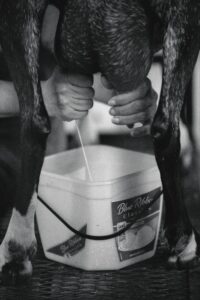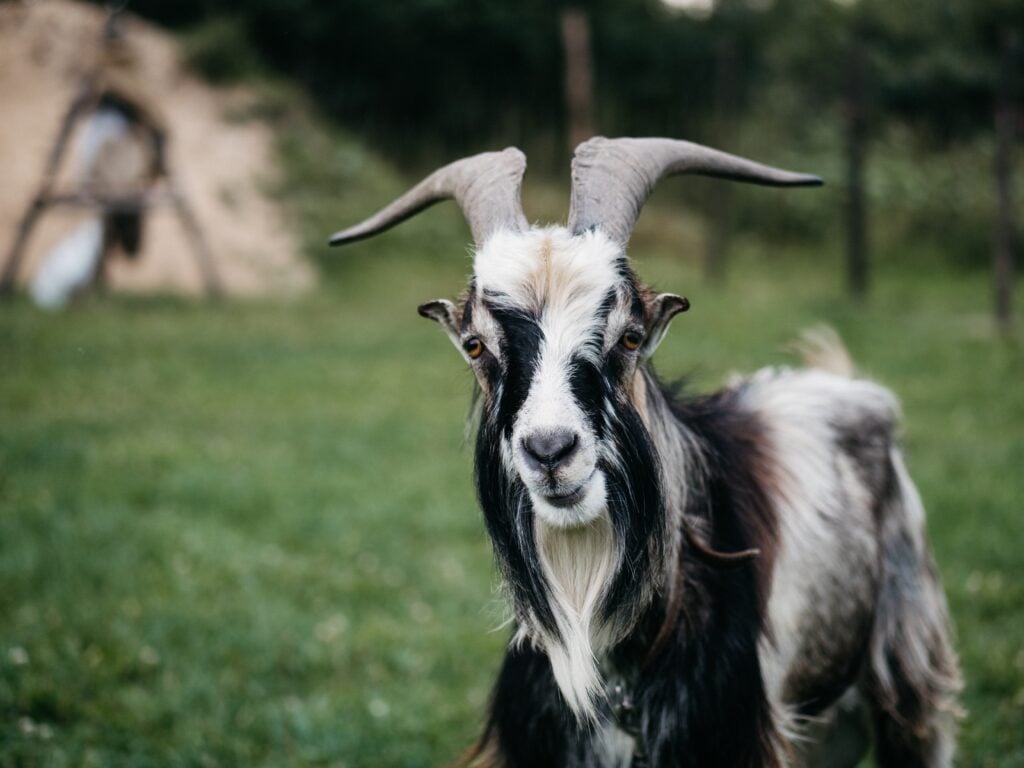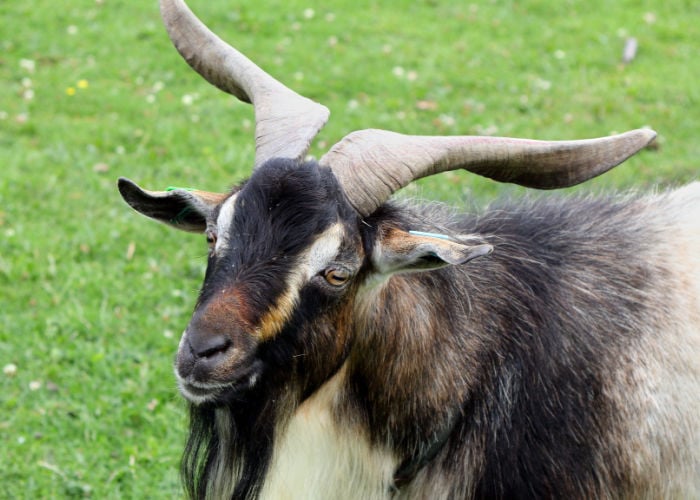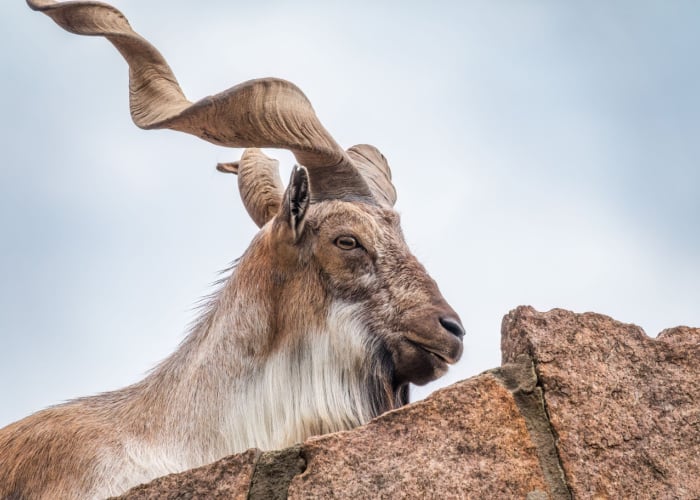The Sarda goat breedis known for its versatility and adaptability to various environmental conditions.
Originating from the Sardinia hillside region in Italy, these domestic goats have gained recognition for their exceptional meat and milk production capabilities.
In this comprehensive guide, we will explore the characteristics, uses, and care requirements of the Sarda goat breed.
Sarda Goat Characteristics
Sarda goats are a heritage breed withmany colors, large horns, airplane ears, and long shaggy coats.
There aren’t any notable color differences between bucks and does, so this is not a good gender identifier.
Instead, look at the size and weight of the animal and the beard.
Bucks are slightly taller, heavier, and have longer beards than the does.
What Do Sarda Goats Look Like?
Sarda goats are stout, medium-sized goats.
Their horns have a thick circumference and medium length and rise from the goat’s head in a V-shape.
The ends of the horns twist outward and backward. Both males and females have similar-sized and shaped horns.
Their coat is long, soft, and shaggy.
The coats tend to shine and look more vibrant in the summer and get more dull and shaggy in the winter.
Sarda Goat Size
Sarda goats fall into the medium-sized category.
Adult males weigh between143 to 165 pounds, while adult females are slightly smaller and usually weigh between99 to 121 pounds.
Males are30 to 30.5 inches tall at the shoulder; females are27.5 inches tall.
Sarda Goat Colors
Most Sarda goats have awhite, off-white, or cream-based coatand then have some two-toned shading.
Black, brown, gold, gray, light lemon, rust red, and orange are common secondary colors to primary creamy or white colors.
They can also be roans (of any color), pied, or solid grey.
Many Sarda goat keepers appreciate their colorful variations, as it makes the herd an aesthetically pleasing calico color.
Sarda Goat Breed Temperament
This breed is nimble, has well-developed muscles, andnavigates rugged and hilly terrain with ease.
They stay close to their herd, are highly social, and tend to begentle around humans.
It takes time for them to socialize well with people, though, but they can be good companions with time, patience, and plenty of treats.
Sarda goats tend to stick with their own breed.
他们是wary of outsiders and like to be with their own familiar herd mates whenever possible.
Though Sardas aredocile, they are stillrecommended for intermediate and up goat keepersand are not best suited for children.
If you’re a beginner or want a good goat friend for your kids, look into thesefriendly goat breedsinstead.
他们是great foragers who can thrive on less-than-ideal pastures, even with arid soil.
Sarda Goat Origin and History
The Sarda goat breed finds its roots in theisland ofSardinia, located in the Mediterranean Sea, just off the west coast of Italy.
These goats have a long history, dating back to ancient times when they wereprimarily raised for their meat and milk production.
Over the centuries, the breed has evolved and adapted to the local conditions of rugged, hilly, temperate Sardinia, developing its unique characteristics and resilience.
Their Sardinian island has arid soil, so they have learned to forage skillfully.
They can survive on their own in the wild with little to no human interference.
We believe that they have someMaltese goatinfluence in the bloodlines.
Today, the Sarda goat is most popular in Nuoro and Cagliari, Sardinia.
It’s one of the few Italian goat breeds recorded and protected by theAssociazione Nazionale della Pastorizia,or “the National Association of Pastoralists” in English.
This organization maintains the herdbooks for indigenous sheep and goat breeds.
What Are Sarda Goats Used For?
The Sarda goat breed is known for its dual-purpose capabilities, making it valuable for both meat and milk production.
The goats excel in providinghigh-quality meat, rich in flavor and tenderness, making them sought after in the culinary industry.
Additionally, Sarda goats havegood milk-producing potential, with the ability to yield a significant amount of nutritious milk.
他们是sometimes kept aspasture ornaments or pets or used for their fiber,but this is not as common.
Sarda Goat Meat Production
Sarda goats are highly regarded for their meat production qualities.
The breed exhibits excellent growth rates and muscle development, producing flavorful and tender meat.
The meat is appreciated for its distinct taste and is often sought after by consumers who value quality and traditional flavors, especially in Italy and throughout the Mediterranean region.
Sarda Goat Milk Production
Sarda does produce up to16 gallons (62 liters) of milkper lactation.
You can also expect0.88 to 2.2 pounds of milkper day per goat.
The milk is3.94% protein and 4.5 to 6% fatwith a good, rich flavor.
It has favorable milk coagulation properties, making itideal for cheese-making.
Most does accept milking well, stand still, and are calm while in the stand.
You can expect Sarda goats to lactate250 to 290 daysafter delivering their kids.
Sarda Goat Breed Population and Reproduction
Experts estimate that there are 300,000 Sarda goats in the Mediterranean region, with 29,000 individuals recorded in the official herd book.
Sarda goats are not included in the Livestock Conservancy in the US, so their North American numbers are relatively unknown.
How Long Are Sarda Goats Pregnant?
Most Sarda goats are pregnant for148 to 155 days or about five months.
This period represents the time from mating to kidding (the birth of kids).
Does have one breeding cycle per year, while the bucks can cover up to thirty does in a season.
How Many Kids Do Sarda Goats Have?
Sarda goat mothers will haveone to four goat kidseach time they give birth, with twins and triplets being the most common.
The number of kids born can depend on factors such as genetics, nutrition, and overall health of the doe.
Most individuals will consistently have the same number of offspring per kidding year after year.
The number of kids per birth is often hereditary too.
Pay attention to this when choosing new members for your herd or choosing which of your does you allow to breed.
Average Sarda Goat Lifespan
Sarda does mature at five to fifteen months old; bucks mature at three to fifteen months.
Does can start breeding at eighteen months, while bucks can start at a year old.
Most Sarda goat lifespans are not well recorded, but a good estimate would be seven to fourteen years old.
Sarda Goat Common Predators
Like many other goat breeds, Sarda goats can face threats from various predators.
Predatory animals such as wolves, coyotes, and dogs pose a risk to the safety and well-being of the goats.
但社区和流浪狗通常biggest threat to goat herds.
Every region comes with different threats, so look for local solutions that are most effective and applicable to your area.
Implementing proper fencing and predator deterrent measures is crucial to safeguarding the herd.
Electric fencesare always a great idea]; they keep goats in and unwanted visitors out.
The Pros and Cons of Raising Sarda Goats
Raising Sarda goats has both advantages and considerations that should be taken into account.
Let’s explore the pros and cons of raising Sarda goats:
Pros
- Dual-purpose breed with both meat and dairy production capabilities.
- Adaptability to various climates and environmental conditions. Tolerates semi-arid to arid pastures well.
- Intelligent and self-sufficient breed. Usually does not require help during kidding season.
- Docile temperament, making them easy to handle.
- Good reproductive capacity with two to three kids per kidding season.
- Milk is well-suited for cheese-making
- Attractive, various coat colors create a beautiful calico-like herd.
Cons
- Extremely limited availability outside of Sardinia. Difficult, if not impossible, to find in the United States and Canada. May have to import from Sardinia.
- Not suitable for brand-new or inexperienced goat keepers.
- Does not enjoy the company of other goat breeds– wants to be kept with their own kind.
- Not ideal for fiber uses.
How To Care for Sarda Goats
Caring for Sarda goats involves various aspects to ensure their health, well-being, and productivity.
Vaccination or Biosecurity Measures
Vaccinations and biosecurity measures help protect Sarda goats from common diseases and reduce the risk of illness or infection.
Quarantine new goats and goats who temporarily left your farm.
You should also change shoes or sanitize both hands and shoes when entering your property.
Being careful not to spread germs or bacteria from one goat to another and from one farm to another will immensely help you keep your herd healthy and safe.
We’ve covered biosecurity in great detailhere.
Deworming and Proper Herd Management
Regular deworming, along with proper herd management practices, including consistent pasture rotation and proper nutrition, ensures optimal health and productivity.
Be sure to read our guide onhow to deworm goats.
Hoof Care
Provide plenty of large rocks or gravel for your goats to walk on to keep their hooves in good condition naturally.
Regular trimming and maintenance of hooves prevent hoof-related issues and discomfort in the goats.
Shelter and Enclosures
Providing adequate shelter and secure enclosures protect Sarda goats from adverse weather conditions and potential predator attacks.
Good Hygiene Practices
Maintaining cleanliness in the goat housing area, feeding equipment, and water sources minimizes the risk of diseases and promotes a healthy environment.
They should always have access to clean, fresh water and nearly constant access to forage.
Sarda goats prefer brush, undergrowth, vines, briars, tree saplings, and “weeds” over pastures, hay, and alfalfa.
Sarda Goat Nutrition
Most Sarda goats prefer to browse and forage brushy, weedy, and woody plants rather than live off grass, pasture, hay, or alfalfa.
Goats need at least7% crude protein,with growing, pregnant, and lactating goats requiring more.
Goats are among the most efficient domestic animals in their water use; however, only~10% of body water lossmay prove fatal.
FAQ about the Sarda Goat Breed
Here are some of the most commonly asked questions about Sarda goats and their answers.
Are Sarda Goats The Same as Sarda Sheep?
Sarda goats and Sarda sheep are entirely different species.
While they both share the same name due to their origin in Sardinia, Italy, they are distinct species with different characteristics and uses.
Sarda goats are specifically bred for their meat and milk production, whereas Sarda sheep are raised for their wool and meat.
Do Sarda Goats Make Good Pets?
Sarda goats are primarily bred for agricultural purposes rather than as pets.
They have specific management requirements and are better suited for farm environments.
However, individual goats can have different temperaments, and with proper socialization and care, some Sarda goats can develop friendly personalities.
Are Sarda Goats Kid-Safe?
Sarda goats can be kid-safe depending on their individual temperaments and their exposure to handling and socialization.
With that said, as a whole, Sarda goats are not the best-suited breed for kids, especially small children.
Other breeds are better for young goat enthusiasts.
是Sarda山羊初学者Friendly?
Sarda goats are generally regarded as intermediate (and up) breeds.
Some individuals may be suitable for new goat keepers, but as a whole, this breed is better for more experienced goat farmers.
Do Sarda Goats Like Hot Climates?
Sarda goats are well-suited for hot climates.
They have developed adaptability to the Mediterranean climate of Sardinia, which includes hot and dry summers.
These goats have the ability to withstand high temperatures and thrive in arid environments.
However, proper shade, access to clean water, and good ventilation are essential for their well-being in hot climates.
Do Sarda Goats Like Cold Climates?
Sarda goats have a good tolerance for most cold climates.
Their thick coats provide insulation against low temperatures, allowing them to adapt to colder regions and cold snaps.
它仍然是重要的为他们提供适当的年代helter and protection from harsh weather conditions, including wind and excessive moisture, to ensure their comfort and health during colder periods.
A break from the wind and moisture is key to keeping them healthy and happy during colder months.
Final Thoughts on the Sarda Goat Breed
The Sarda goat breed offers a unique blend of meat and milk production capabilities, adaptability, and docile temperament.
主要发现在撒丁岛地区aly, these goats have gained recognition for their valuable contributions to the farming industry.
Their ability to thrive in diverse environments, coupled with their excellent meat and milk production qualities, makes them a preferred choice for farmers seeking a versatile and productive breed.
By implementing proper care practices and addressing specific breed-related considerations, goat keepers can maximize the potential of the Sarda goats and contribute to the preservation and sustainability of this remarkable breed.
And by understanding their characteristics, uses, and care requirements, goat enthusiasts can appreciate the potential of the Sarda breed and consider their suitability for their own farming operations.
Interested to learn more about different goat breeds?
Check out our recommended reads below!





